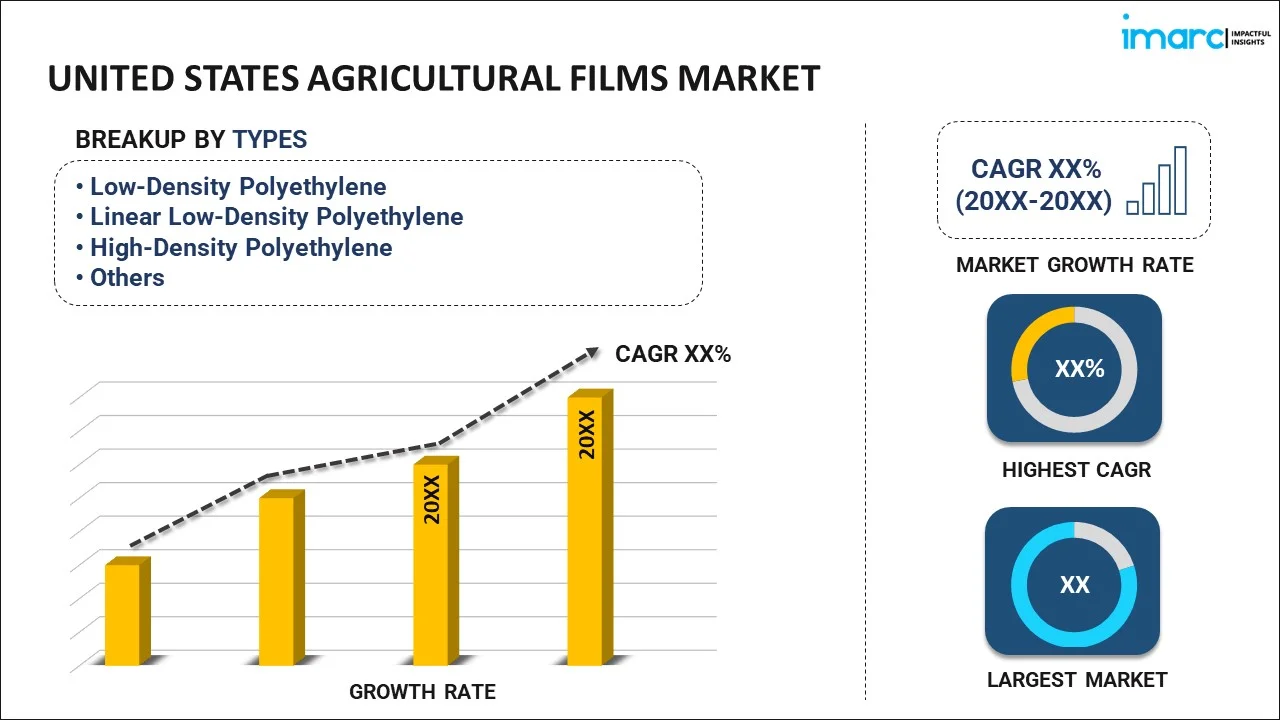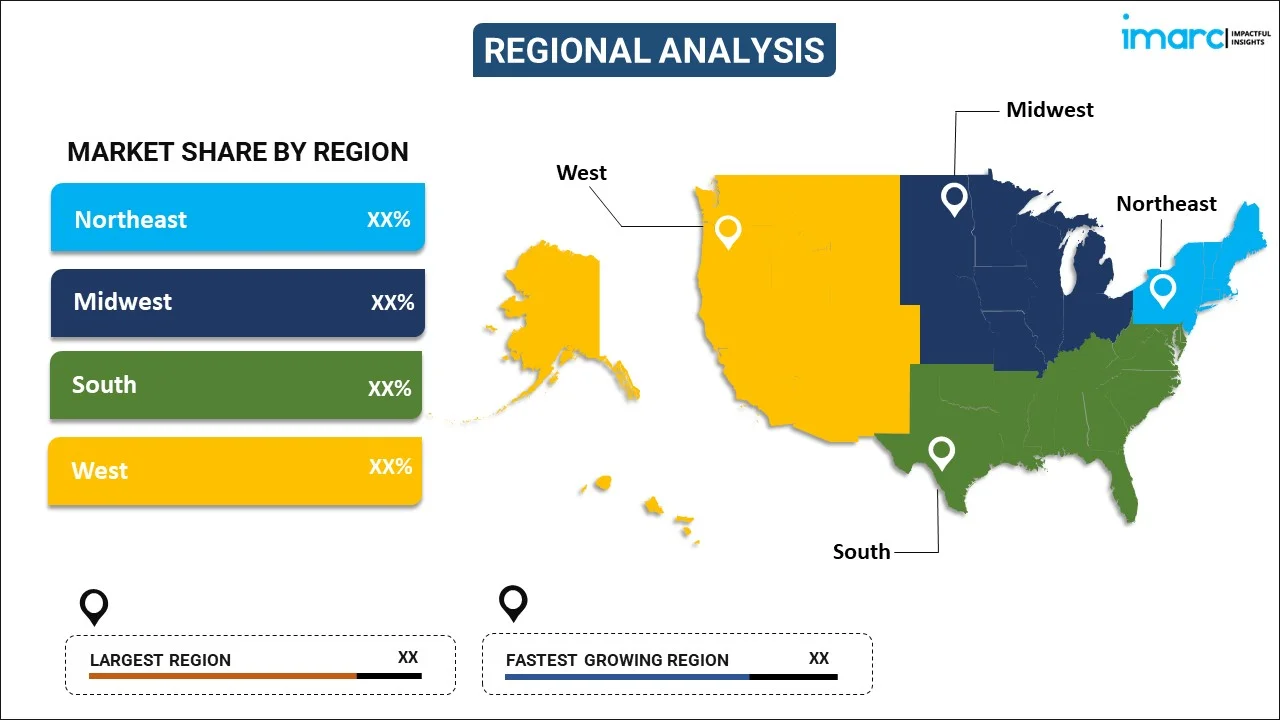
United States Agricultural Films Market Report by Type (Low-Density Polyethylene, Linear Low-Density Polyethylene, High-Density Polyethylene, Ethylene Vinyl Acetate, and Others), Application (Greenhouse, Silage, Mulching, and Others), and Region 2025-2033
Market Overview:
United States agricultural films market size reached USD 2.9 Billion in 2024. Looking forward, IMARC Group expects the market to reach USD 5.2 Billion by 2033, exhibiting a growth rate (CAGR) of 5.99% during 2025-2033. The ongoing R&D in materials science, which have led to the creation of advanced films with improved properties, such as increased durability, UV resistance, and enhanced thermal properties, is driving the market.
|
Report Attribute
|
Key Statistics
|
|---|---|
|
Base Year
|
2024 |
|
Forecast Years
|
2025-2033
|
|
Historical Years
|
2019-2024
|
| Market Size in 2024 | USD 2.9 Billion |
| Market Forecast in 2033 | USD 5.2 Billion |
| Market Growth Rate (2025-2033) | 5.99% |
Agricultural films are thin plastic materials used in various aspects of modern farming to enhance crop production and protect plants. These films serve multiple purposes, such as controlling weed growth, conserving soil moisture, regulating temperature, and preventing diseases. Common types of agricultural films include mulch films, greenhouse films, and silage films. Mulch films are laid over the soil to suppress weed growth, retain moisture, and regulate soil temperature. Greenhouse films create a controlled environment for plants, optimizing conditions for growth. Silage films are used to wrap and preserve forage crops for animal feed. These films contribute to sustainable agriculture by improving resource efficiency, increasing yields, and reducing the need for chemical inputs. Despite their benefits, the environmental impact of plastic films is a concern, leading to ongoing R&D of biodegradable alternatives in the agricultural sector.
United States Agricultural Films Market Trends:
The agricultural films market in the United States is propelled by various factors, with the increasing regional population and the consequent surge in food demand standing out as the primary driver. As the population continues to grow, there is a heightened need for efficient agricultural practices to ensure food security. Moreover, the growing awareness among farmers about the benefits of agricultural films in enhancing crop yield further fuels market expansion. In addition to this, the rising adoption of advanced farming techniques, including the use of agricultural films for mulching, greenhouse cultivation, and soil protection, contributes significantly to market growth. Furthermore, the escalating trend towards precision farming, which involves the use of technology to optimize crop yields, acts as a catalyst for the agricultural films market. The integration of agricultural films in precision farming practices aids in better water management, weed control, and temperature regulation, fostering increased productivity. Additionally, the impact of climate change on traditional farming practices has led to a greater reliance on protective agricultural films to mitigate adverse weather conditions and optimize crop growth. This adaptability to changing environmental dynamics positions agricultural films as indispensable tools in modern agriculture, driving sustained growth in the market.
United States Agricultural Films Market Segmentation:
IMARC Group provides an analysis of the key trends in each segment of the market, along with forecasts at the country level for 2025-2033. Our report has categorized the market based on type and application.
Type Insights:

- Low-Density Polyethylene
- Linear Low-Density Polyethylene
- High-Density Polyethylene
- Ethylene Vinyl Acetate
- Others
The report has provided a detailed breakup and analysis of the market based on the type. This includes low-density polyethylene, linear low-density polyethylene, high-density polyethylene, ethylene vinyl acetate, and others.
Application Insights:
- Greenhouse
- Silage
- Mulching
- Others
A detailed breakup and analysis of the market based on the application have also been provided in the report. This includes the greenhouse, silage, mulching, and others.
Regional Insights:

- Northeast
- Midwest
- South
- West
The report has also provided a comprehensive analysis of all the major regional markets, which include the Northeast, Midwest, South, and West.
Competitive Landscape:
The market research report has also provided a comprehensive analysis of the competitive landscape in the market. Competitive analysis such as market structure, key player positioning, top winning strategies, competitive dashboard, and company evaluation quadrant has been covered in the report. Also, detailed profiles of all major companies have been provided.
United States Agricultural Films Market Report Coverage:
| Report Features | Details |
|---|---|
| Base Year of the Analysis | 2024 |
| Historical Period | 2019-2024 |
| Forecast Period | 2025-2033 |
| Units | Billion USD |
| Scope of the Report | Exploration of Historical Trends and Market Outlook, Industry Catalysts and Challenges, Segment-Wise Historical and Future Market Assessment:
|
| Types Covered | Low-Density Polyethylene, Linear Low-Density Polyethylene, High-Density Polyethylene, Ethylene Vinyl Acetate, Others |
| Applications Covered | Greenhouse, Silage, Mulching, Others |
| Regions Covered | Northeast, Midwest, South, West |
| Customization Scope | 10% Free Customization |
| Post-Sale Analyst Support | 10-12 Weeks |
| Delivery Format | PDF and Excel through Email (We can also provide the editable version of the report in PPT/Word format on special request) |
Key Questions Answered in This Report:
- How has the United States agricultural films market performed so far and how will it perform in the coming years?
- What is the breakup of the United States agricultural films market on the basis of type?
- What is the breakup of the United States agricultural films market on the basis of application?
- What are the various stages in the value chain of the United States agricultural films market?
- What are the key driving factors and challenges in the United States agricultural films?
- What is the structure of the United States agricultural films market and who are the key players?
- What is the degree of competition in the United States agricultural films market?
Key Benefits for Stakeholders:
- IMARC’s industry report offers a comprehensive quantitative analysis of various market segments, historical and current market trends, market forecasts, and dynamics of the United States agricultural films market from 2019-2033.
- The research report provides the latest information on the market drivers, challenges, and opportunities in the United States agricultural films market.
- Porter's five forces analysis assist stakeholders in assessing the impact of new entrants, competitive rivalry, supplier power, buyer power, and the threat of substitution. It helps stakeholders to analyze the level of competition within the United States agricultural films industry and its attractiveness.
- A competitive landscape allows stakeholders to understand their competitive environment and provides an insight into the current positions of key players in the market.
Need more help?
- Speak to our experienced analysts for insights on the current market scenarios.
- Include additional segments and countries to customize the report as per your requirement.
- Gain an unparalleled competitive advantage in your domain by understanding how to utilize the report and positively impacting your operations and revenue.
- For further assistance, please connect with our analysts.
 Request Customization
Request Customization
 Speak to an Analyst
Speak to an Analyst
 Request Brochure
Request Brochure
 Inquire Before Buying
Inquire Before Buying




.webp)




.webp)












